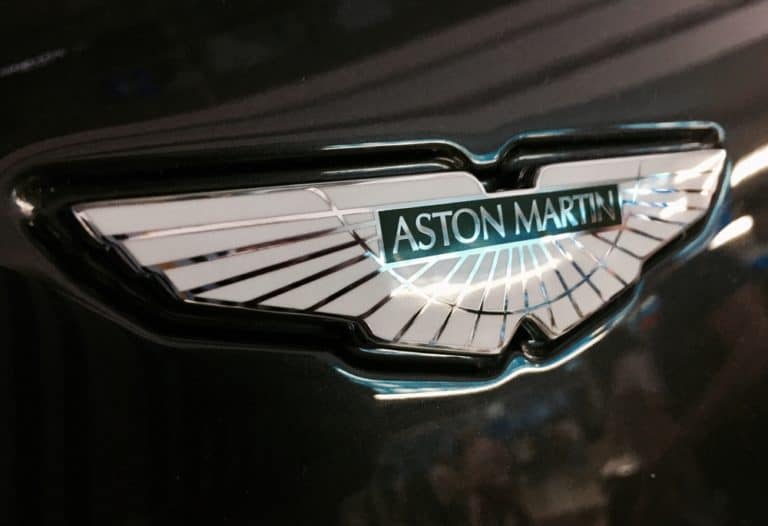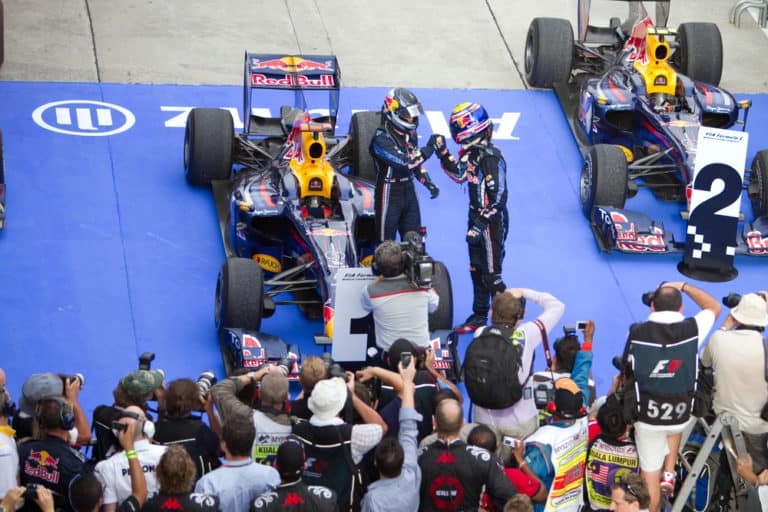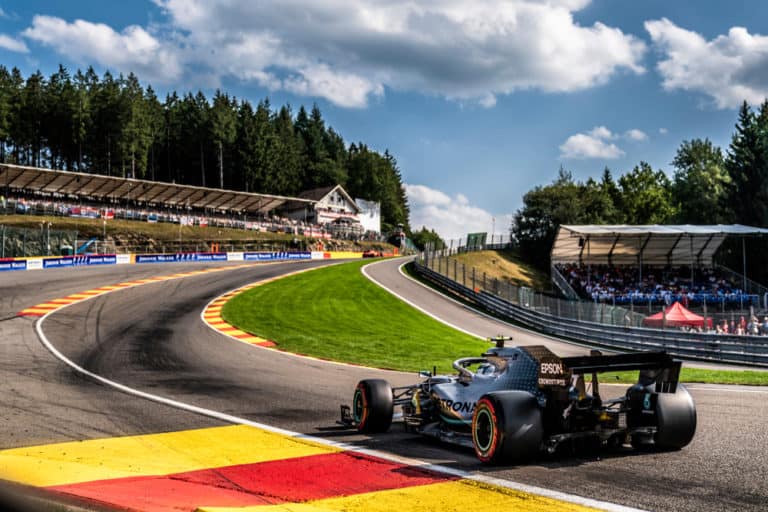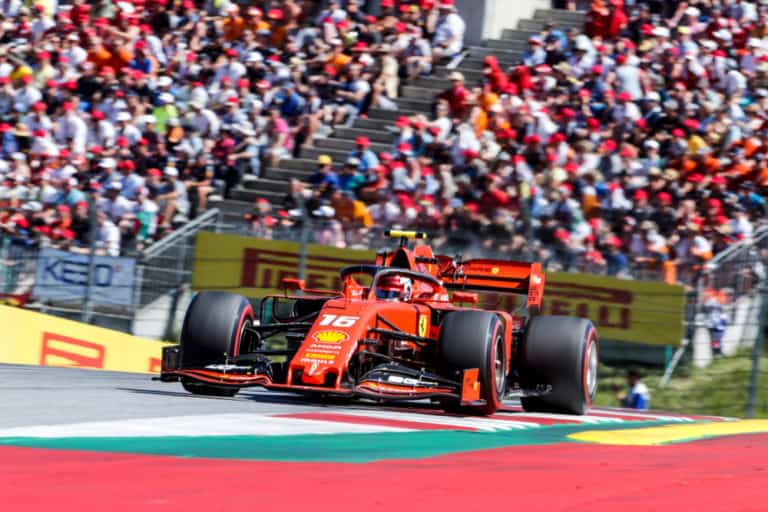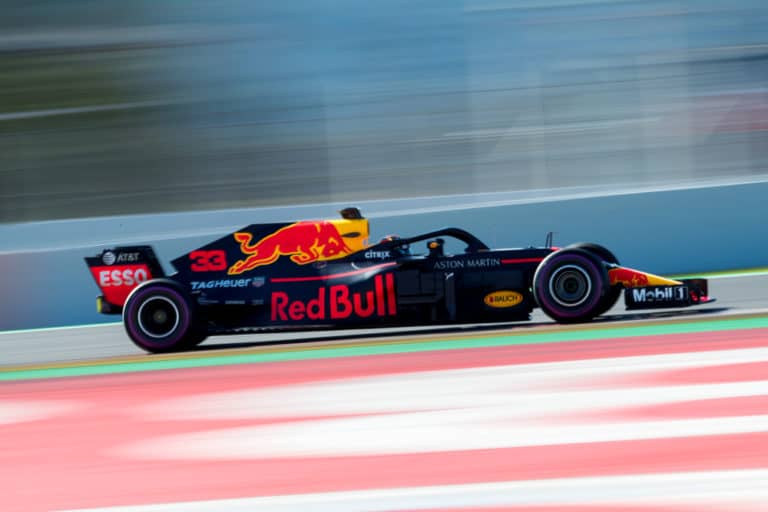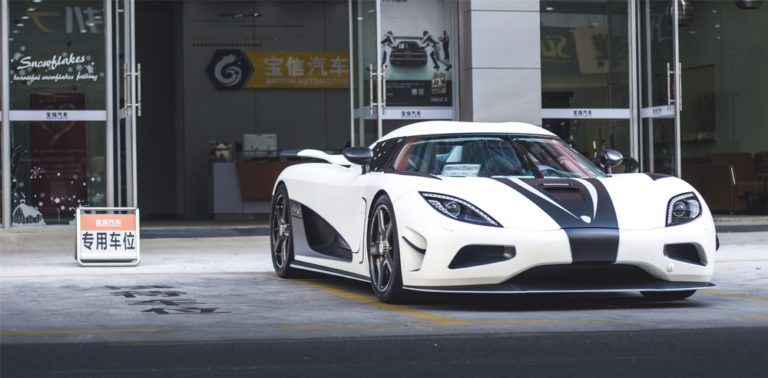Editorial credit: mypokcik / Shutterstock.com
Formula 1 is an unpredictable sport, where anything can happen from one moment to another, changing the course of the race or the championship. The weather is part of the sport and the protagonist on many occasions, which can shake up the grid or create chaotic situations.
Rain always makes for entertaining races as the track conditions become more difficult, leading to many incidents, spins, and overtaking. In one way or another, it evens out the performance of the cars, so the talent of each driver behind the wheel is most important. This has often led to unexpected wins and results.
Throughout history, there have been many races in the rain, some of which have been remembered for the chaos, the tremendous on-track entertainment, or the unexpected outcome. Let’s take a look at some of the best.
1. 1976 Japanese GP
The 1976 Japanese Grand Prix saw one of the greatest title showdowns in history. After his accident at the Nurburgring, Niki Lauda returned to racing for the season’s final rounds and was fighting with James Hunt for the title. The last round, the Japanese Grand Prix, was marked by heavy rain, coupled with fog and standing water on the track, and Lauda, who, in a debate between drivers, unsuccessfully proposed to cancel or postpone the race, retired on lap 2 as a precaution.
On the other hand, James Hunt decided to continue racing. The Briton, who started second, took the lead on the first lap and dominated the entire race in the rain until he had to stop on lap 64 of 73 due to a slow puncture.
The Briton came out of the pits in fifth position and needed at least a fourth-place finish to take the title. Thus, Hunt gave it his all around the Fuji circuit in the difficult conditions and, on the penultimate lap, overtook Alan Jones and Clay Regazzoni to become the 1976 world champion by just one point.
That season has gone down in history as one of Formula 1’s most iconic rivalries and is depicted in the 2013 film “Rush.”
2. 2012 Brazilian GP
The 2012 Brazilian Grand Prix also saw one of the greatest title showdowns in recent times and history. It was the season’s final round, and Sebastian Vettel’s Red Bull had a 13-point lead over Fernando Alonso’s Ferrari, which needed to win and Vettel to finish fifth or lower.
Vettel qualified fourth, while Alonso could only finish eighth. On Sunday, the race started dry, with just a few drops, but the rain intensified as the laps went by, and soon, all drivers had to stop to put on intermediate tires.
On the first lap, Alonso climbed up to third, while Vettel had contact in Turn 4 that made him spin and sent him to the back of the grid, losing a lot of time and with a damaged sidepod.
Alonso remained third for most of the race and moved up one more place due to Lewis Hamilton’s retirement to finish second. On the other hand, Vettel, who lost a lot of time on the first lap, gave his all to catch the rest of the grid, completing an incredible comeback.
The rain helped the German, who created chaos on the grid, causing numerous retirements and a Safety Car that allowed him to close the gap and overtake numerous places. In the final laps, he caught up with his compatriot Michael Schumacher, who was running sixth, and let him pass, thus winning his third title by only 3 points ahead of Alonso in one of the most chaotic and intense races in F1 history.
3. 2011 Canadian GP
The 2011 Canadian Grand Prix, lasting 4 hours and 4 minutes, is the longest race in the history of Formula 1. The race started under heavy rain, with Sebastian Vettel starting from the pole position, followed by Fernando Alonso, while Jenson Button, the day’s protagonist, started seventh.
The race started under the Safety Car due to track conditions, and when it ended, Button had a touch with his teammate, Lewis Hamilton, causing a second Safety Car. The Briton, who was given a stop-and-go penalty, dropped to fifteenth, and shortly afterward, the race was suspended for two hours due to heavy rain.
After the restart, an accident with Alonso caused a puncture for Button, who pitted again and came out last. After that, Button was one of the first drivers to switch to dry tires, gaining a significant advantage and making his way up the grid, climbing to no less than second place.
On the last lap, Sebastian Vettel, who had dominated the entire race, made a mistake, and Button won the race against all odds. From then on, a 4-hour limit was set for races in 2012, which was lowered to 3 hours in 2021.
4. 2008 Brazilian GP
The 2008 Brazilian Grand Prix, the season’s last round, saw the most epic finish in history. Felipe Massa, the local hero, was on his way to his first title, and it was enough for him to win and for his rival, Lewis Hamilton, to finish sixth or worse.
Massa did everything he could to win the title, taking the pole position and dominating the entire race. The Brazilian didn’t count on the rain that came at the end of the race, creating chaos on the grid.
Hamilton, who had spent most of the race between fourth and sixth, was sixth on the final lap, having switched to full wet tires. Massa crossed the finish line in first position, with the supposed winning combination, and he and his family began to celebrate the title, as did the grandstands.
However, in the last corner, Hamilton overtook Timo Glock’s Toyota, the only driver who had not switched to full wet tires and suffered a lot. Thus, Hamilton won his first title in the last corner of the season’s final race, when his opponent already thought he was the winner, in such a spectacular and exciting outcome that makes it the most epic ending in the history of Formula 1.
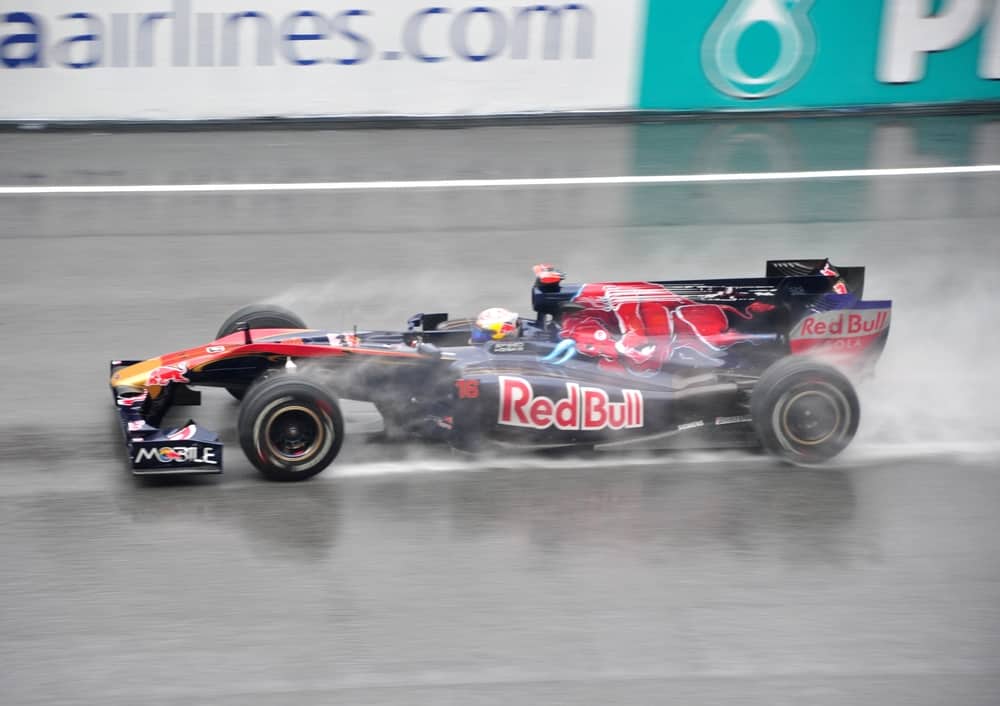
5. 2006 Hungarian GP
The 2006 Hungarian Grand Prix had several protagonists: Jenson Button, Fernando Alonso, Michael Schumacher, Pedro de la Rosa, and the rain. Alonso and Schumacher, the title contenders, received a 2-second penalty on their qualifying lap time for not respecting the flags. Thus, the Spaniard started from the fifteenth position, while the Kaiser from the twelfth.
Other drivers, such as Jenson Button, were sent to the back of the grid for power unit changes. Meanwhile, Kimi Raikkonen and Felipe Massa started in the front row. The race started in the rain, and at the start, we saw two of the best performances in F1 history: Alonso climbed to sixth position in just one lap, while Schumacher took fourth.
On lap 26, Raikkonen had an accident and retired, causing a Safety Car, so the McLaren of Pedro de la Rosa, who had started fifth, moved up to second. Shortly after, Jenson Button, who had made a silent comeback, overtook de la Rosa to take second.
With 19 laps to go, Alonso made a pit stop to change tires and refuel, and upon exiting, went straight into the barriers at Turn 2 due to a badly tightened nut on the right rear tire.
Thus, Jenson Button took the lead and won his first Formula 1 race. In contrast, Pedro de la Rosa, who had overtaken Schumacher before the German retired, took the only podium of his career, followed by Nick Heidfeld, in one of the most entertaining races in recent times.
6. 1984 Monaco GP
The 1984 Monaco Grand Prix will always be remembered as the race that brought Ayrton Senna to prominence. In that race, a young Senna was driving a Toleman-Hart, one of the backmarkers of the grid, on one of the rainiest days in the Principality in living memory.
While the great drivers of the time, such as Alain Prost, Keke Rosberg, Rene Arnoux, and Niki Lauda, started from the first positions, the young Senna began from the thirteenth place. However, under the heavy rain, the Brazilian made a spectacular comeback, and on lap 31, he was already second, just five seconds behind race leader Prost.
Senna’s pace was four seconds per lap faster than Prost’s, but it was on that lap that the stewards decided to stop the race due to the weather. The Frenchman took the win, and Senna looked like he had been robbed, but everyone knew his name from then on.
It was a chaotic race where the most talented drivers shone regardless of their car. The other driver who stood out was Stefan Bellof, who drove an obsolete Tyrell and climbed from twentieth position to third, with a pace even better than Senna’s. However, he was later disqualified for violating the minimum weight.
7. 2007 European GP
The 2007 European Grand Prix was held at the Nurburgring and was one of the most chaotic races of the last decades, which left some historic moments. The race started with a dry track and threatening clouds, and Markus Winkelhock, who was replacing Christijan Albers in the modest Spyker team, was the only driver to make a pit stop to put wet tires at the end of the formation lap.
Right after the start, it started to rain heavily, and many riders soon went off the track, especially in turn 1. Six drivers ended up simultaneously in the gravel of that turn, among them Lewis Hamilton, leader of the championship, who inexplicably received help from a crane from the stewards and was the only one to return to the track.
Amidst the chaos and drivers going to the pits, the most unexpected driver, Winkelhock, led the only race he competed in Formula 1. A few moments later, the race was suspended due to rain and restarted when conditions were better. The German lost many positions at the restart and retired a few laps later due to a hydraulic problem.
After that, Fernando Alonso and Felipe Massa fought intensely for victory, with several touches between them. Finally, the Spaniard won, tightening the championship even more. Both drivers had a big discussion on the podium about their battle.
8. 2019 German GP
Lewis Hamilton took his fourth pole position of the season at the 2019 German Grand Prix, while his biggest rivals, the Ferraris, started from tenth (Leclerc) and twentieth (Vettel) place, suggesting a good weekend for Mercedes as it celebrated its 125th year in motorsport.
However, the changing weather on Sunday triggered a crazy race that will be hard to forget. The race started with heavy rain, which gradually stopped, and the drivers started with full wets, switched to intermediates, and then to dry tires.
While the track was still very slippery, this tire transition created a lot of chaos as the rain intensified at times, with drivers changing too early and ending up in the wall. Leclerc, Hamilton, Bottas, and Hulkenberg were among the drivers who ended up in the barriers, although the Briton, who made up to 6 pit stops, could continue, simply to score points.
Thus, the grid was completely shaken up, with drivers retiring, those who lost positions by going off, and those who held on. Amidst the chaos, Max Verstappen won the race, followed by Sebastian Vettel, who completed an incredible performance from the last position. Daniil Kvyat’s Toro Rosso completed the podium with an unexpected third place.
9. 1981 Canadian GP
The 1981 Canadian Grand Prix, the season’s penultimate round, was raced in the rain, where visibility was almost zero. The local hero, Gilles Villeneuve completed one of the most incredible performances in history.
The Canadian and his teammate, Didier Pironi, started tenth and twelfth, while the title contenders, Nelson Piquet, Carlos Reutemann, and Alan Jones, started from the first positions. During the race’s early stages, Villeneuve moved up to second position, setting successive fastest laps, and closely followed by John Watson’s McLaren, which finally managed to overtake him.
The Canadian had a touch on the first lap with Rene Arnoux that damaged his front wing but did not affect his speed too much. However, at the moment of overtaking some lapped drivers, Villeneuve hit Elio de Angelis from behind, spinning and with his front wing now clearly damaged.
With 12 minutes left in the race and knowing that entering the pit lane would cost him the podium, the Canadian continued like that. The deterioration of the wing increased with each turn, and ended up twisting, getting bent right in the driver’s line of sight. Despite this, Villeneuve continued to race at the limit, taking advantage of all his on-track references and giving his all with his prodigious car control and bravery.
Three laps later, the front wing eventually came off, and Villeneuve finally crossed the finish line in third position behind Jacques Laffite and John Watson.
10. 1998 Belgian GP
The 1998 Belgian Grand Prix is one of the most chaotic races in living memory. The rain appeared before the start, and on the first lap, 13 drivers were involved in one of the most shocking accidents in history during the start. The accident caused numerous retirements, wrecked cars, and debris all over the track, so the race was red-flagged. Fortunately, no one was injured.
Mika Hakkinen, one of the title contenders, was one of the drivers who had to retire on the first lap, leaving his rival Michael Schumacher with a clear path to victory.
However, the German, leading the race after it restarted, encountered David Coulthard’s lapped car and, due to poor visibility, impacted his rear end, causing him to abandon the race. The Kaiser was so angry that he went looking for him in the garage moments later, and his team had to stop him.
The Jordan team was the biggest beneficiary of this accident, which achieved a 1-2 with Damon Hill and Ralf Schumacher in the Briton’s last victory and the team’s first.
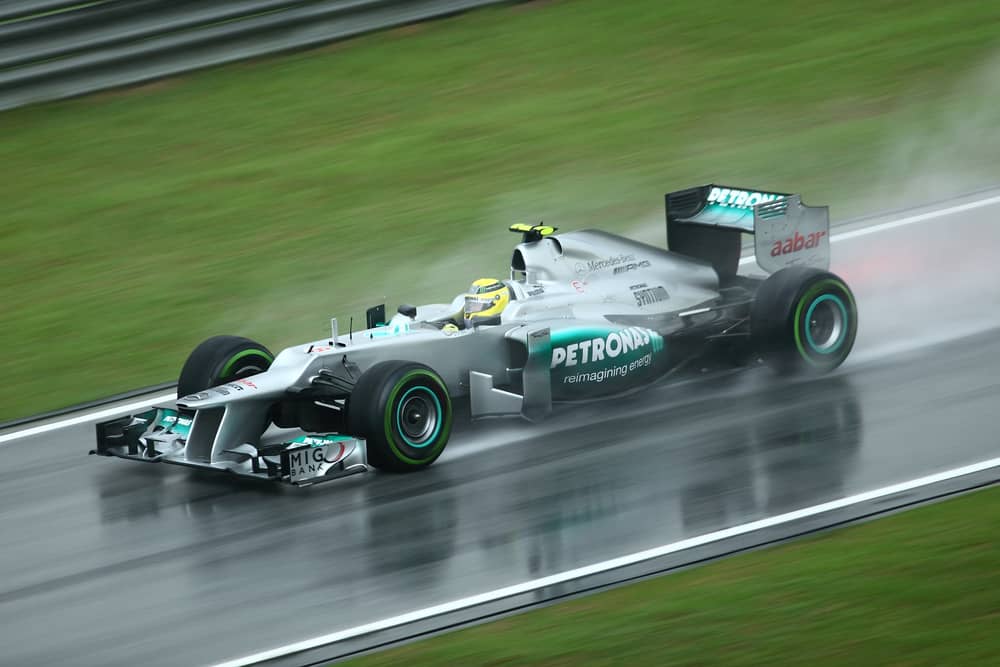
11. 2008 Monaco GP
In 2008, Formula 1 arrived at one of its most historic venues, Monaco, with Kimi Raikkonen leading the championship, followed by Felipe Massa and Lewis Hamilton. Massa took the pole position in a 1-2 for Ferrari, while Hamilton was third and his teammate, Kovalainen, fourth.
The race started with a wet track from previous rain, although the forecast indicated it would rain again later. Hamilton took second on lap 1, and within a few laps, the rain was intensifying, causing some accidents, among them Hamilton, who touched the barriers and damaged his tire and had to make a pit stop, which sent him to the back of the grid.
Monaco was becoming a race of survival, and after the accidents of David Coulthard and Sebastien Bourdais, who retired, the first Safety Car came out. Massa was still leading when the race restarted, followed by Raikkonen, Kubica, and Hamilton. After a stop-and-go penalty by Raikkonen and a mistake by Massa, Kubica took the lead until he pitted, and the Brazilian regained the lead, with Hamilton 16 seconds behind.
Hamilton extended his pit stop more than 20 laps longer than Massa, overcutting him and leaving the pits with almost 20 seconds advantage, already on dry tires. Thus, after a driving exhibition with an effective strategy and a remarkable comeback after being in the last positions at the beginning, Hamilton became the first British driver to win in Monaco since Graham Hill in 1969.
12. 1991 Brazilian GP
Formula 1 arrived at the Interlagos circuit in Brazil in 1991, with the national hero, Ayrton Senna, having never won at home despite being a two-time world champion. In that edition, the Brazilian got the pole position and dominated the race until the gearbox started to fail in the final laps; at the same time, it began to rain, making the track very slippery.
First, the fourth gear failed, and then the fifth and third, so Senna had to complete the last laps with the sixth gear engaged. This not only meant a lack of speed but a great physical effort to maintain it, and the Brazilian suffered cramps in various parts of his body while trying to stay in the lead.
Finally, the Brazilian crossed the finish line in the first position, three seconds ahead of Ricardo Patrese’s Williams in his hardest-fought victory. On the podium, Senna had little strength to lift the trophy in front of all his fans.
13. 1989 Australian GP
Heavy rain marked the 1989 Australian Grand Prix from start to finish, with the organization giving an extra practice session on Sunday for the drivers to find the right settings. Most drivers complained about the bad weather and that the track was flooded and asked not to run, although the race finally started.
Senna started from pole position, followed by Alain Prost, and they began a short-lived battle, as an accident by Jyrki Jarvi Letho caused a red flag. Prost retired after that, as he did not want to race in that weather, leaving Senna without any rival. The Brazilian soon consolidated the lead, 9 seconds ahead of Pierluigi Martini’s Minardi, which was slowing down the rest of the drivers.
Martini was overtaken shortly after by Thierry Boutsen, Ricardo Patrese, and Alessandro Nannini. However, when Senna was about to lap Nelson Piquet and Martin Brundle, he miscalculated and hit the Briton, leaving both out of the race. Between that and some retirements in two laps, the Williams were first and second, ahead of Nannini’s Benetton.
Past the halfway point of the race, the survivors completed an uneventful second half of the race, and Boutsen won the race, followed by Nannini, with Patrese third, who had been very cautious. The one who took a risk was fourth-placed Satoru Nakajima, who, after spinning on the first lap, came back to fourth, setting the fastest.
Conclusion
Rain is unpredictable, and when it appears, it makes for chaotic races, with numerous accidents, position changes, and epic comebacks, as we have seen, causing some of the best and most entertaining races.
References
- https://www.reddit.com/r/formula1/comments/mt2dfd/best_extreme_weather_races/
- https://www.mclaren.com/racing/inside-the-mtc/9-wet-races-to-whet-your-F1-appetite/
- https://es.motorsport.com/f1/news/winkelhock-grua-hamilton-victoria-alonso-nurburgring-2007/4499061/
- https://www.motorpasion.com/formula1/monaco-1984-la-carrera-que-encumbro-a-ayrton-senna
- https://www.topgear.es/noticias/motorsport/mejores-carreras-formula-1-mojado-73920
- https://www.caranddriver.com/es/formula-1/g39783697/mejores-carreras-formula-1/
- https://www.autolimite.com/mas-info/malabares-bajo-el-diluvio-del-gp-de-canada-1981
- https://elotroladodelascarreras.blog/2018/05/27/f1-2008-monaco-hamilton-magistral/

